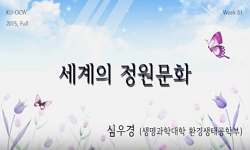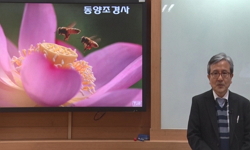(연구의 배경 및 목적) 최근 「수목원·정원의 조성 및 진흥에 관한 법률(이하, 정원법)」이 지난 7월부터 본격적으로 시행됨에 따라 산림, 정원 산업이 국내 블루오션으로 떠오르고 있다. 정...
http://chineseinput.net/에서 pinyin(병음)방식으로 중국어를 변환할 수 있습니다.
변환된 중국어를 복사하여 사용하시면 됩니다.
- 中文 을 입력하시려면 zhongwen을 입력하시고 space를누르시면됩니다.
- 北京 을 입력하시려면 beijing을 입력하시고 space를 누르시면 됩니다.

한국의 정원문화 활성화를 위한 전통주택정원과 현대주택정원 비교 분석 = A Study on Comparing Traditional Garden and Modern Garden for Developing Garden Culture of Korea
한글로보기https://www.riss.kr/link?id=A101248949
- 저자
- 발행기관
- 학술지명
- 권호사항
-
발행연도
2015
-
작성언어
Korean
-
주제어
전통정원 ; 현대정원 ; 정원문화 ; 공간비율 ; 주택정원 ; Traditional Korean Gardens ; Moden Gardens ; Garden Culture ; Space ratio ; House garden
-
KDC
658
-
등재정보
KCI등재
-
자료형태
학술저널
- 발행기관 URL
-
수록면
113-124(12쪽)
- DOI식별코드
- 제공처
-
0
상세조회 -
0
다운로드
부가정보
국문 초록 (Abstract)
(연구의 배경 및 목적) 최근 「수목원·정원의 조성 및 진흥에 관한 법률(이하, 정원법)」이 지난 7월부터 본격적으로 시행됨에 따라 산림, 정원 산업이 국내 블루오션으로 떠오르고 있다. 정원은 개인의 것이라 할지라도 정원 조성은 넓은 의미에서 지역사회의 환경조성과 직결되고, 개인생활에 있어서 풍부한 정서생활에 커다란 역할을 하고 있으며 인류 문화에 대한 ``가장 오래된 문명의 표현방법``이라 할 수 있다. 그 중 개인주택정원은 전체 대지에서 주택이 차지하는 비율을 제외한 비건폐지이지만 사람들의 생활과 직결되는 곳으로 주거환경에서는 없어서는 안되는 중요한 역할을 하고 있다. 그러나, 그 동안의 개인주택정원은개인적 취향에 맞추어 조성되는 것이기는 하나 정원 조성 기준, 방법, 관리에 대한 연구가 미흡하고, 변화하는 시대에 따라 정원유형, 가치 등을 반영한 정원 조성 기법이 미흡한 실정이다. 따라서, 본 연구에서는 그 동안의 정원이 가지는 공간, 시설물, 식재에 대해 변화 양상을 분석하여 향후 정원이 가지는 가치와 조성 방법을 제시하고자 하였다. (연구방법) 연구는 전국을 대상으로 전통정원, 현대정원 각 30개소 총 60개소에 대한 현장조사를 실시하여 시설물, 식재, 공간구성에 대해 조사분석을 하였다. (결과) 연구 결과 시설물의 경우 전통정원에서 현대정원으로 넘어오면서 관리시설, 휴식시설, 농업시설, 경관시설 비중이 높아졌으며 경계시설, 이동시설물은 감소하였다. 비율로 분석을 해보면 전통정원에서 현대정원으로 넘어오면서 약 1.5% 시설물 면적이 감소하였으나 전통정원과 비교해 보았을 때 그 비율은 크지 않은 것으로 나타났다. 그러나, 시설물 종류로 보았을 때 전통정원은 생활양식에 따른 시설물이 주로 나타났으나 현대정원의 경우 활동, 휴식시설물 위주로 조성되는 것으로 나타났다. 식재의 경우 전통정원은 과실수 위주로 조성을 하였으며 현대정원은 감상, 활동, 계절감을 느낄 수 있는 식물로 조성을 하였다. 공간구성의 경우 전통정원과 현대정원 모두 바닥 비율이 높게 나타났으나 전통정원에서 현대정원으로 넘어오면서 바닥면적은 약 18.2% 감소하였으며, 식재 면적의 경우 현대정원으로 넘어오면서 약 17.3% 증가하였다. (결론) 정원 문화 활성화를 위해서는 다양한 활동이 나타날 수 있는 공간구성, 시설물, 식재 방안이 필요하다. 본 연구에서 나타난 바와 같이 전통정원에서 현대정원으로 넘어 오면서 시설물, 식재, 공간 비율이 활동 위주로 변화된 것을 볼 수 있으며 변화된 양상에 따라 다양한 활동이 나타날 수 있는 정원 조성이 필요하다. 그 중 공간구성은 잔디밭, 텃밭 면적을 높여 휴식 및 휴게 활동, 생산 활동이 적극적으로 나타날 수 있도록하고, 식재는 다양한 경관 형성을 나타낼 수 있도록 계절감이 있는 식물을 식재하도록 한다. 또한, 시설물은 벤치, 퍼고라, 그네등 활동이 나타나는 시설물 위주로 조성하는 것이 바람직하다.
다국어 초록 (Multilingual Abstract)
(Background and objective of this study) The Act on the Construction and Promotion of Arboretums and Gardens was implemented last July, and forest and garden industries have been received the Blue Ocean designation. In spite of the fact that gardens b...
(Background and objective of this study) The Act on the Construction and Promotion of Arboretums and Gardens was implemented last July, and forest and garden industries have been received the Blue Ocean designation. In spite of the fact that gardens belong to individuals, constructing gardens is directly related to a local society``s environmental development. Further, this activity plays an important role in fostering rich emotions. In fact, it is the oldest expression method of civilization. The garden in a private residence is an open space-the site left after the building site has been excluded; it is very important in terms of the residential environment as it is directly connected to people``s lives. Although a personal garden is constructed according to an individual``s preferences, there have not been enough researches on standards, methods, and management of garden construction projects. In addition, there are not many construction methods that reflect the value of the garden in a changing society. Therefore, this research presents the value and construction method pertaining to gardens of the future based on an analysis of trends in spaces, facilities, and plantings in existing gardens. (Method) Field research was performed on 60 gardens (i.e., 30 traditional gardens and 30 modern gardens) throughout the nation; accordingly, spaces, facilities, and plantings were analyzed. (Results) In terms of facilities, management facilities, rest facilities agricultural facilities, and scenery facilities were analyzed; it was noted that modern garden facilities have fewer boundaries and transportation options than traditional gardens. In fact, boundaries decreased by 1.5% for modern gardens, although ratios remained almost the same. Traditional gardens usually have facilities for living, whereas modern gardens have facilities for relaxing or engaging in activities. Regarding plantings, traditional gardens contain more fruit trees, whereas modern gardens incorporate more plants for their appreciation value, related activities, and seasonal events. Concerning space composition, both traditional gardens and modern gardens reflect a preference for flooring, though the amount of flooring decreased by 18.2% in modern gardens. However, the size of plantings increased by 17.3%. (Conclusion) Space composition, facilities, and planting methods that allow various activities in a single space need to be developed to promote a garden culture. Regarding space composition, relaxation or orchestration of activities can be encouraged by increasing the size of a lawn or kitchen garden. Concerning planting, trees that can present the changes of seasons should be used to make create sceneries that incorporate benches, pergolas, or swings.
동일학술지(권/호) 다른 논문
-
문화자원 활용공간의 장소 정체성 강화방안 -도시형 한옥마을과 전통마을을 중심으로-
- 한국공간디자인학회
- 송영민 ( Youngmin Song )
- 2015
- KCI등재
-
- 한국공간디자인학회
- 김민영 ( Minyoung Kim )
- 2015
- KCI등재
-
- 한국공간디자인학회
- 김형경 ( Hyungkyung Kim )
- 2015
- KCI등재
-
- 한국공간디자인학회
- 권윤경 ( Yun Yeong Kwon )
- 2015
- KCI등재




 KCI
KCI KISS
KISS



